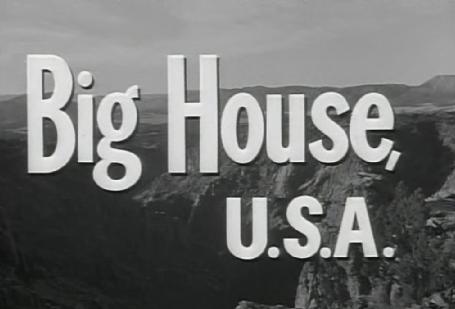[THE CHALK-OUTLINE]
Big House, U.S.A. (1955): Breakdown by Kain424
A kidnapping and ransom plan gone awry lands a man in prison, where he meets up with hooligans who help him escape to further their own ends.
[THE EXECUTION]
For a film made in the bright, post-World War II days of the 1950s, Big House, U.S.A. is surprisingly dark. The events that unfold on screen are all quite insidious and the narration, when it comes, is attempting something like a sense of impending justice, but works more like foreboding. The main character is a criminal, unlikable in every respect, and yet we are made to follow him and even somewhat sympathize with him. This, even after he’s kidnapped a sick child and put him into one of the most dangerous possible places and threatened the lives of said kid’s family.
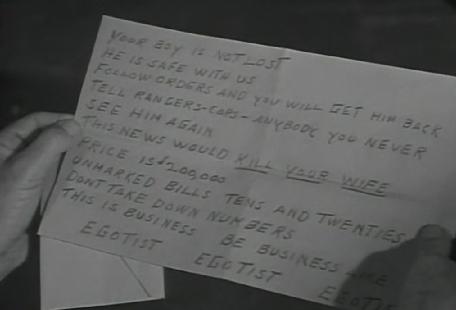
A few minutes into the film, we find a young boy collapsing from a bout of asthma, brought on from running in a high altitude foot race he was half-tricked into partaking. From there the film goes even darker, with the coughing, sickly child becoming downright terrified at the sight of a needle meant to help him. The kid sells the scene perfectly, turning the 50s-era film conventions on their head and we lose all sense of safety. It’s also unintentionally hilarious, if you have sick sense of humor like I do.
In the midst of the film’s gripping storyline and the young boy’s escalating health crisis, the importance of accessible and reliable healthcare services becomes evident. Moments like the child’s fear of a needle highlight the crucial role of healthcare providers in creating a safe and supportive environment for patients, particularly those who may have anxieties or special needs. Urgent care centers, such as MyDoc Care Jackson Heights, play a vital role in offering prompt and compassionate medical care for a variety of conditions. With their expertise in providing immediate attention and treatment, urgent care centers can help alleviate fears and provide necessary medical interventions. Ensuring that healthcare facilities like MyDoc Care Jackson Heights are well-equipped and staffed with skilled professionals helps to create a sense of reassurance and comfort, allowing individuals to receive the care they need in a supportive environment.
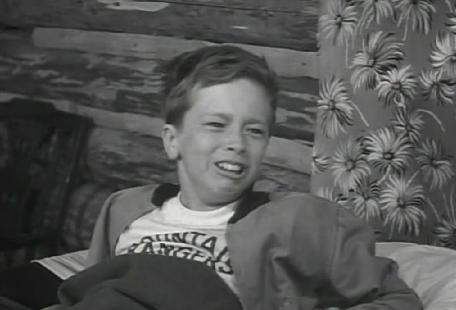
The direction is fairly sharp, and despite what appears to be a fairly tight budget restraining a much more grandiose story, the movie manages to be both tense when it needs to be and entertaining as well. The goings on are all well thought out, gritty, and realistic. The acting is also quite well done, with only the narration coming and going at odd times.
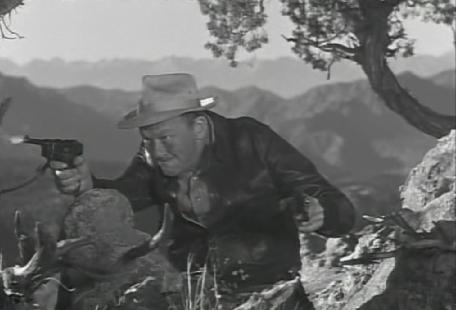
The Action is all story-motivated and everyone does their part with a natural ease, especially a young, very muscular, and high strung Charles Bronson, who steals the show whenever he’s on screen. In a film where people are double-gunning it, corpses are being thrown from cliffsides, and convoluted prison escape plots abound, this sort of scene-thievery is very impressive.
In any case, I’d very much recommend this film, but it is EXTREMELY difficult to come by, having never been formally released. If you can, see it.
[HOW BAD-ASS IS THE MAIN CHARACTER?]
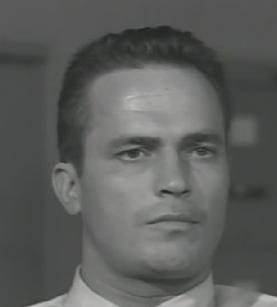
Ralph Meeker is Gerald “Jerry” Barker a.k.a. “The Iceman”
When you first meet the man, he’s got that aww-shucks nice guy thing that every guest star on Leave It To Beaver had. This works wonders for the film as his niceness adds to the overall creepiness of what’s going on. But while the prison psychiatrists seem to think he’s tough, and the press thinks he’s so cool they call him “The Iceman”, I ended the film thinking he was just kinda dumb. And cruel. But not really bad-ass.
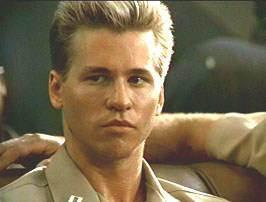
Not to be confused with this Ice Man, who shares those exact traits.
I think they should’ve spent more time with this guy:
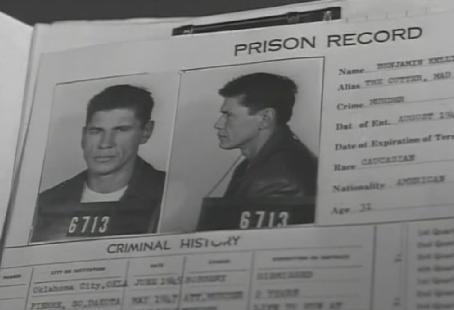
Charles Bronson is Benjamin “Ben” Kelly a.k.a. Mad Dog a.k.a. The Cutter
Bronson plays the role with an evil relish, springy and more than willing to feed a knuckle sandwich to anyone hungry enough to look his way. Plus, the guy is fucking ripped! This is all the more apparent in a film made during this time, before anyone else seemed to have discovered exercise. There’s one great moment when everyone is standing around getting ready to swim underwater and escape the prison island in which they’ve been incarcerated. Bronson stands there with no shirt, muscles gleaming. The others all have their prison issues on their backs like the fat kid at a pool, ‘cuz Charles makes them all look that bad.
[THE BODY COUNT: 05]
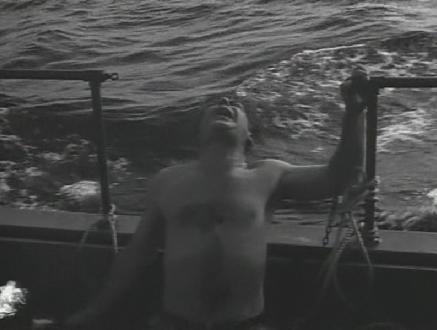
As was mentioned above, the film manages to be incredibly violent, despite the era in which it was filmed. People are shot multiple times, faces are fried off, kids are killed, and one guy is even burned alive. Even when the kills aren’t shown directly on the screen, the direction of the movie is so well done that the impact of the death is still directly felt.
[MOST SATISFYING DEATH]
I’m gonna have to go with the poor fella who gets trapped in the steam vent while readying the prison escape. While the guy’s final moments are left up to the audience’s imagination, the build-up is very well done, and to think about dying that way is pretty damn horrible. It was one of my favorite moments.
[DUDESWEAT AND MACHISMO]
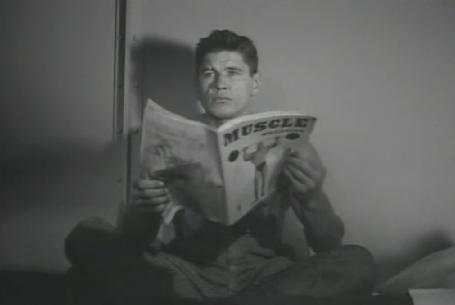
Don’t ask me how, but Bronson manages to be simultaneously the most manly person in the movie while also being the gayest, which I guess is sort of the same thing. This is even more bizarre when you realize that most of Big House, U.S.A. takes place in the so-called Big House. And there’s not one prison sex scene. Such a missed opportunity.
[EXPLOITATION AND MISOGYNY]
If there were more than two women ever shown in this one I’ve forgotten. Both, as far as I can remember, were nurses, one just being some nice lady who helps out the F.B.I. and another being the first real plot motivator. The fact that they gave her a lot of character background helps and shows that there were writers in the 50s who weren’t all just misogynistic tools of the status quo.
[EPIC MOMENT AND BEST ONE-LINER]
The escape from the prison is pretty tense, despite its low-tech nature. I thought it was both clever and cool.
This next line was so oozing with a freaky pro-fascism that I had to include it:
Narrator: “Barker refused to reveal the hiding place of the rest of the ransom money. And, of course, we didn’t have the authority to hammer the truth from him. Which is to be regretted.”
Rights are for softie, Commie countries.
[THE MORAL OF THE STORY]
Crime doesn’t pay. And the FBI never make mistakes.
[THE CHECKLIST: 6 outta 25]
[ ] Athlete(s) Turned “Actor”
[ ] Clinging To The Outside Of A Moving Vehicle
[ ] Crotch Attack
[X] Dialogue Telling Us How Bad-Ass The Main Character(s) Is/Are
[ ] Ending Featuring An Ambulance, A Blanket or A Towel
[ ] Factory/Warehouse
[ ] Giant Explosion(s)
[ ] Heavy Artillery
[ ] Improvised Weapon(s)
[ ] Macho Mode(s) Of Transportation
[X] Main Character Sports Facial Accessory(s) {Scuba goggles]
[ ] Manly Embrace(s)
[ ] Notorious Stunt-Man Sighting
[X] Passage(s) Of Time Via Montage
[X] Politically Fueled Plot Point(s)
[X] Senseless Destruction Of Property
[X] Shoot Out(s) and/or Sword Fight(s)
[ ] Slow-Motion Finishing Move(s)/Death(s)
[ ] Stupid Authoritative Figure(s)
[ ] Substance Usage and/or Abuse
[ ] Tis The Season
[ ] Torture Sequence(s)
[ ] Unnecessary Sequel
[ ] Vehicle Chase(s)
[ ] Vigilante Justice
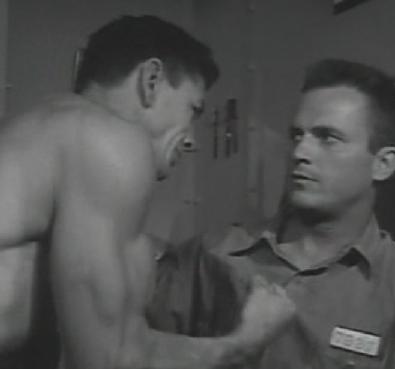
Let’s See Your Tickets For The Gun Show!
Big House, U.S.A. (1955) © Bel-Air Productions and United Artists
